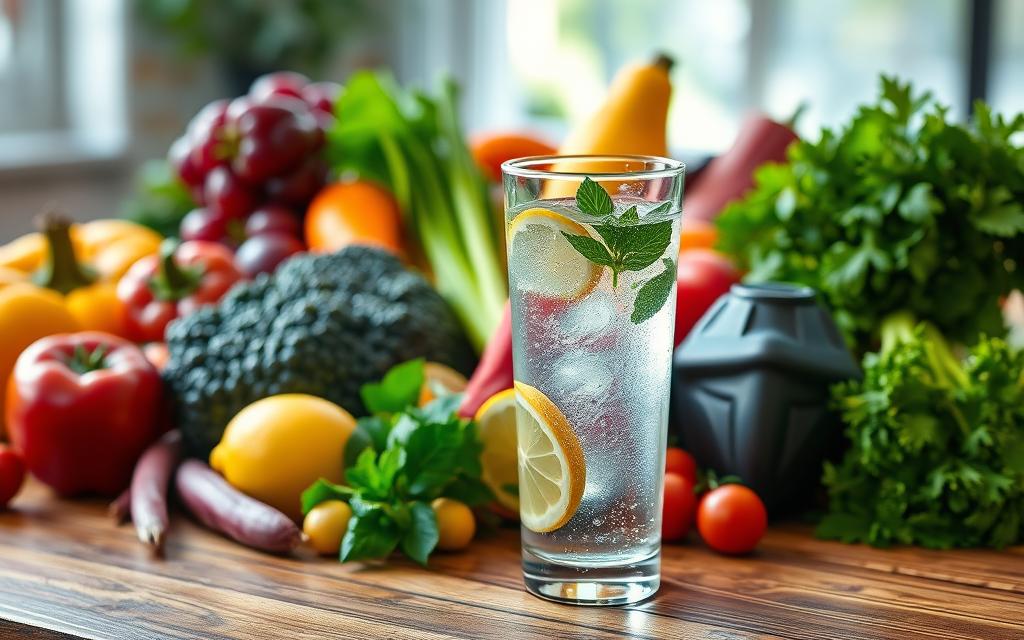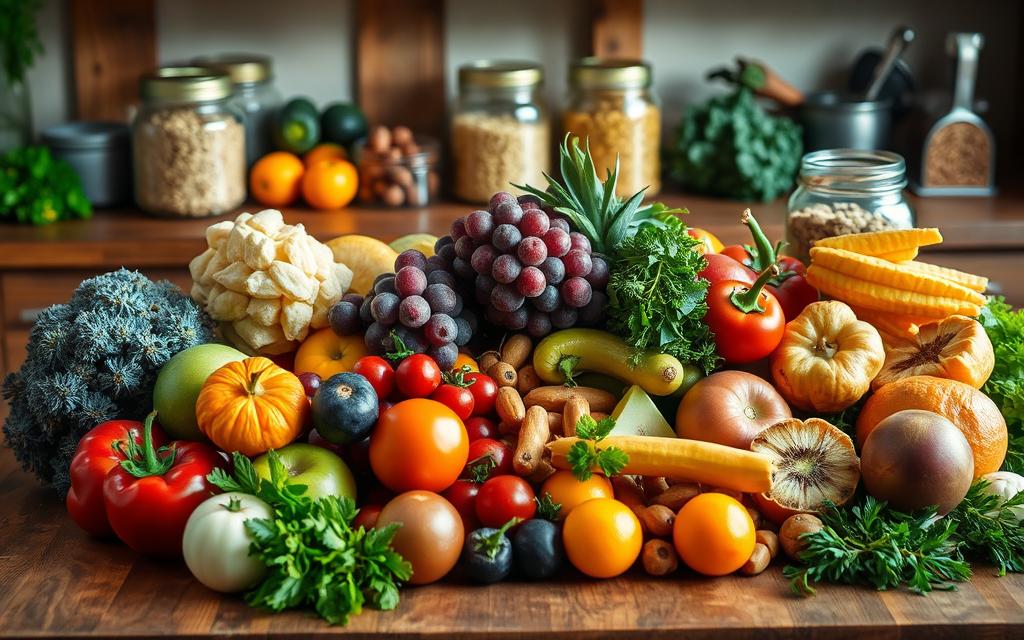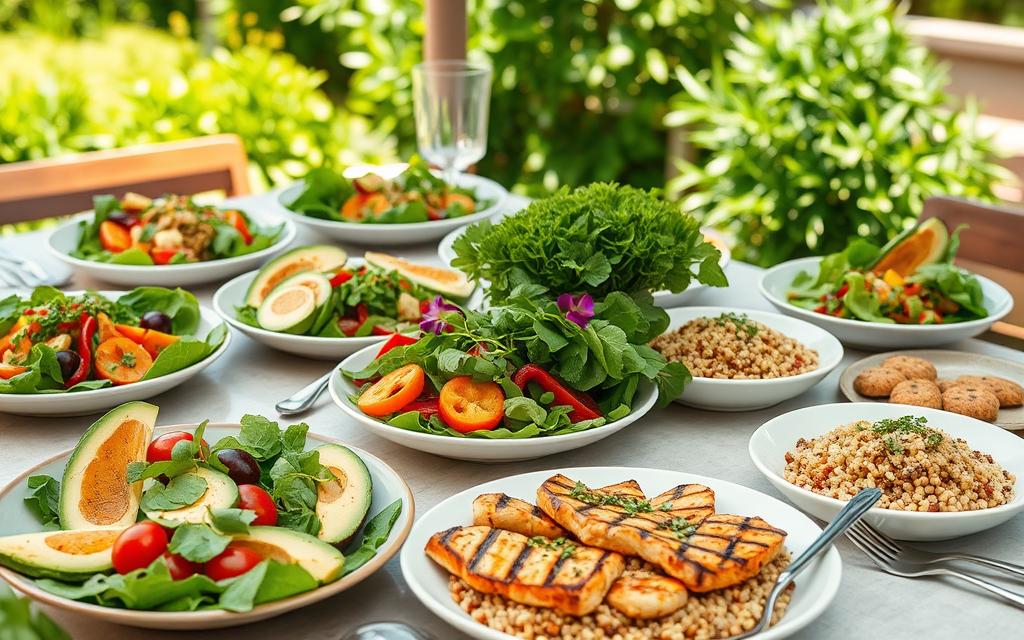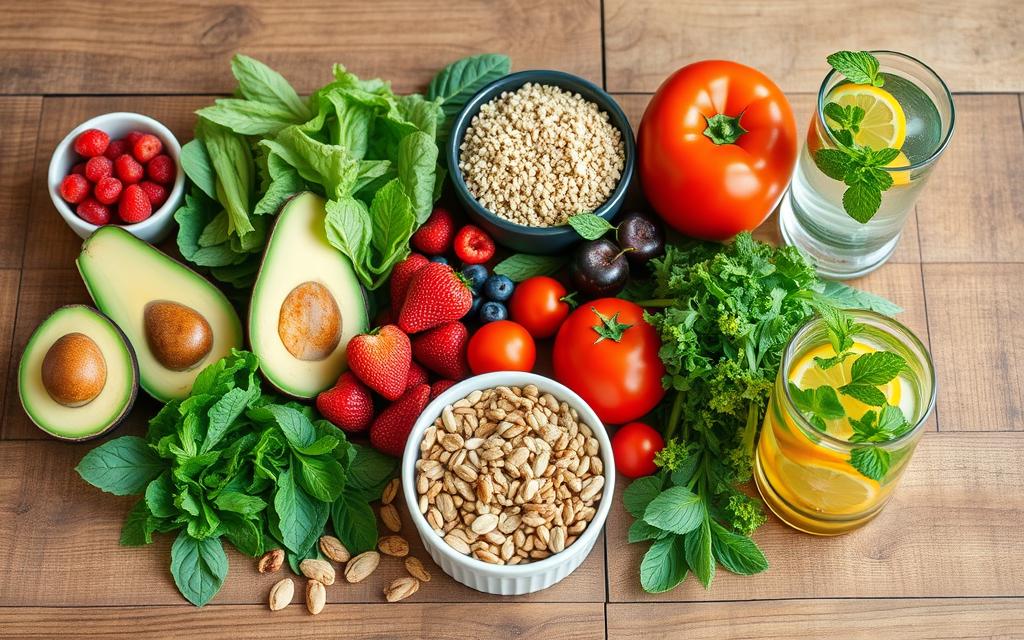We’ve all been there, standing in front of the pantry, wondering what to choose. The brightly colored packages promise quick fixes and health benefits. But eating clean is more than a diet; it’s a journey to nourish our bodies and regain our energy.
It’s about changing how we think, focusing on whole foods that help us, not harm us. As we dive into this clean eating guide, remember, every small step counts. It can lower the risk of obesity and heart disease, linked to too much sugar in processed foods.
We invite you to join us on this journey. Together, we’ll discover the “how” and the “why” behind a healthy lifestyle. It’s about putting our health and happiness first12.
Key Takeaways
- Clean eating promotes better overall health and reduced heart disease risk.
- Whole foods are packed with essential nutrients compared to processed options.
- Transitioning to whole foods helps manage blood sugar levels, preventing diabetes.
- Meal preparation can lead to healthier eating habits and reduced cravings.
- Shopping for fresh produce supports local farmers and provides seasonal benefits.
What is Clean Eating?
Clean eating means eating whole, unprocessed foods. It’s about adding fruits, veggies, whole grains, lean proteins, and healthy fats to our meals. We should also cut out foods high in sugar and unhealthy additives.
About 50% of people say they follow clean eating. They avoid processed foods, eat fresh produce, and choose organic options with simple ingredient lists3.
Choosing foods with clean ingredients is key to clean eating. This means picking foods that are fresh, organic, or natural over artificial ones. In fact, 64% of people make these choices3.
Younger people are more likely to follow clean eating. They often learn about it from social media3.
Fruits and veggies are at the heart of clean eating. Fresh fruit is always a good choice4. Whole grains like brown rice and quinoa are also great because they have only one ingredient. We prefer plain Greek yogurt over flavored ones because they have less sugar4.
Clean eating started in the 1990s in bodybuilding. It focused on high protein and low carbs, avoiding sugars and junk food5. Books like “Eat-Clean” by Tosca Reno made it popular among the public5.
But, it’s important to watch out for the dangers of strict clean eating. It can lead to unhealthy eating habits in some5.
Overall, clean eating can help us eat better and feel better. It’s about making smart choices about what we eat.
Importance of Eating Clean for Your Health
Eating clean is key for our health. It focuses on whole foods, giving us the vitamins and minerals we need. This diet can help us lose about 3 pounds a week with exercise6. Plus, regular cardio workouts improve our health even more6.
Studies show that meals with veggies, fruits, lean proteins, and grains are good for us7. Eating small meals throughout the day keeps our energy and metabolism balanced6. Fresh fruits and veggies give us fiber and nutrients, vital for our health.
Following a clean eating diet can prevent diseases like heart disease and diabetes6. It can also help with high blood pressure and cholesterol, maybe even cutting down on medication6. This diet is also affordable and healthy, making it easy for many to follow7.
Understanding Whole Foods
Whole foods are natural and close to their original form. They include fruits, vegetables, whole grains, legumes, nuts, seeds, and high-quality animal proteins. Eating these foods boosts our nutrition and lowers health risks like heart disease and some cancers. Studies show that whole food diets can reduce heart disease risk by 19% and overall death risk by 11% compared to processed food diets89.
Choosing whole foods helps us follow a clean eating plan. This way, we get the good stuff from food without the bad stuff from processed foods. For example, whole food diets can help us avoid extra calories and weight gain. On the other hand, they can lead to losing about 10 pounds in six months and keeping it off8.
Our diets should be high in fiber, with women needing at least 25 grams and men needing 38 grams daily. Fiber helps prevent chronic diseases and keeps our guts healthy8. Whole grains are key for gut health and reducing inflammation. They’re better than refined carbs, which can cause obesity and insulin resistance9. Eating whole foods boosts our immune system and overall health, thanks to vitamins like C, zinc, and selenium8.
| Whole Foods | Benefits |
|---|---|
| Fruits & Vegetables | Lower risk of cancer and heart disease |
| Whole Grains | Reduce inflammation and promote gut health |
| Nuts & Seeds | Provide essential fatty acids and nutrients |
| Legumes | High in protein and fiber |
| High-Quality Proteins | Support muscle maintenance and overall health |
Benefits of Eating Clean
Eating clean does more than help you lose weight. It boosts your energy and sharpens your mind. Studies show that eating foods like fruits, vegetables, fish, and nuts can make your brain work better by 24%10. Also, eating more than 569 grams of produce daily can cut your risk of death by 10%10.

Nutrient-rich foods are key to a healthy lifestyle. They give us the nutrients we need and help us avoid junk food. For example, eating whole grains can lower your risk of dying by 5% for every 28-gram serving per day10. This shows how important it is to eat a variety of foods, which is good for your gut11.
Also, eating foods full of polyphenols can protect your heart. Cooking at home most of the week can help you eat fewer calories and less sugar10. This can help you and your family eat healthier for a long time.
| Benefit | Research Findings |
|---|---|
| Energy Boost | Eating clean can enhance overall energy levels. |
| Mood Improvement | Nutrient-dense foods contribute to better mood regulation. |
| Reduced Mortality Risk | Increased produce intake can lower risk of death by 10%10. |
| Brain Function | A diet rich in certain foods improves brain function by 24%10. |
| Gut Health | Varied diet supports a healthier gut microbiome11. |
How to Start Your Clean Eating Journey
Starting our clean eating journey can seem daunting, but it’s not. We can begin by adding more whole foods to our diet. Choosing foods rich in nutrients helps us feel more energetic and improves our health, from our brain to our heart12. We can start by making one meal a day completely clean, slowly getting used to this new way of eating13.
Cooking at home lets us pick what goes into our meals. Using fresh, local produce boosts our nutrition and helps us avoid foods with high pesticide levels13. Paying attention to how our bodies react to different foods helps us understand what healthy eating means for us12.
Replacing unhealthy foods with better options is a good start. For example, choosing raw nuts over chips helps us make healthier choices. This approach, known as the 80/15/5 rule, guides us to eat 80% whole foods, 15% better processed foods, and only 5% junk13. Being aware of sugar in packaged foods helps us focus on the quality of ingredients, not just calories13.
| Step | Action |
|---|---|
| 1 | Choose whole foods for most meals to ensure nutrient density. |
| 2 | Gradually replace one non-clean item at a time, like trading chips for fresh fruit. |
| 3 | Cook at home to better manage our ingredient choices. |
| 4 | Pay attention to the Dirty Dozen list to minimize pesticide exposure. |
| 5 | Listen to our body’s responses to identify what works best for us. |
By following these clean eating tips, we can make big changes towards a healthier lifestyle. Enjoying the benefits of wholesome nutrition is within reach12.
Eating Clean: Tips for Transitioning
Starting a clean eating journey can greatly improve our health. It’s a step-by-step process that makes it easier and more fun. We don’t have to change everything at once. Instead, we can slowly add more healthy foods to our diet.
Gradually Swap Processed Foods for Whole Foods
It’s smart to slowly switch from processed to whole foods. Processed foods make up about 60% of what we eat. Knowing which foods are processed is key14. By choosing whole fruits, veggies, lean proteins, and healthy fats, we can live healthier15.
Focus on Nutrient-Dense Foods
Choosing nutrient-dense foods like fresh veggies, lean proteins, and whole grains is key. Foods high in added sugars can lead to health problems and weight gain14. Eating foods rich in nutrients boosts our immune system, helps us stay healthy, and keeps our energy up15.
Experiment with Simple Clean Eating Recipes
Trying out simple clean eating recipes is a great way to make mealtime fun. Chef and nutritionist Pederson’s Farms stresses the value of planning and preparing meals15. Adding different ingredients to our meals makes clean eating exciting and improves our health.

Common Misconceptions About Eating Clean
Many people think clean eating means strict diets. But it’s really about enjoying a variety of foods without feeling guilty16. Some also believe it’s too pricey, but using seasonal and local produce can save money17.
About 50% think healthy eating is too costly, even though affordable choices like frozen fruits and veggies are available16. Those who try extreme diets often regain weight, showing moderation is key16.
Some get too caught up in clean eating, leading to unhealthy habits17. Clean eating claims are often exaggerated, with no clear proof of benefits17. It’s better to eat a balanced diet than follow strict rules.
Knowing the truth about clean eating helps us make better food choices. It lets us enjoy healthier eating without stress.
Shopping for Clean Foods: A Guide
Starting a clean eating journey means we need to shop smart. We must learn to find healthy foods in stores and avoid unhealthy ones. Good grocery shopping and reading labels are key to better health.
Shopping the Perimeters of the Grocery Store
Shopping the edges of the store is a great tip. Here, we find fresh fruits, veggies, lean meats, and dairy. About 79% of people think food should be simple and natural, which matches what we find here18.
More and more, people choose organic foods for their health benefits. About 63% of shoppers prefer organic products18. Also, 33% are willing to spend 10% more for organic, showing they value quality18.
Reading Food Labels Effectively
Knowing how to read labels is vital for healthy choices. Look for simple ingredient lists and avoid added sugars or artificial stuff. About 25% of shoppers actually read labels18.
As we focus on clean eating, we should choose products with fewer ingredients. 63% of shoppers like products with fewer than five ingredients19.

| Category | Tips for Clean Eating |
|---|---|
| Produce | Choose seasonal and organic options when possible. |
| Proteins | Opt for lean meats or plant-based alternatives. |
| Dairy | Select organic or grass-fed options for higher nutritional value. |
| Grains | Prioritize whole grains over refined ones. |
Good shopping habits mean being aware of what we eat. Clean eating has grown 33% in five years18. Our choices in the store are key to a healthier life.
Eating Clean at Home: Meal Prep Essentials
Meal prep for clean eating is key to a healthy lifestyle. It helps us plan and prepare healthy foods. This way, we can stick to our clean eating goals.
Planning meals ahead saves time and cuts down on food waste. In the U.S., about 40% of food is wasted. By planning, we can avoid this waste20. Using different cooking techniques makes our meals more nutritious.
How to Plan Your Meals Ahead
Start by picking recipes that fit your clean eating goals. Choose meals with whole, unprocessed ingredients for better nutrition21. For example, Mediterranean chicken salad is healthy with about 400 calories per serving21.
Prep meals in bulk to save time. It can take just an hour a week20. This also helps cut down on grocery costs, sometimes by up to 50%20.
Cooking Techniques for Clean Eating
Choosing the right cooking methods is important. For example, using spaghetti squash instead of pasta cuts down carbs by 75%21. Steaming or slow cooking helps keep nutrients in and saves cleaning time by 20-30%20.
Use fresh, seasonal veggies for better taste and nutrition21. Focus on pantry staples and leftovers to make diverse, appealing meals. This also helps the environment.
By following these meal prep tips, we can make our clean eating routine more sustainable. This keeps our health and wellness a top priority22.
Eating Clean While Dining Out
Dining out doesn’t have to ruin our clean eating plans. By planning ahead and knowing the menu, we can keep our healthy habits. Restaurants in the U.S. often serve too much food, so we need to watch our portions23. Looking for healthy restaurant options means knowing what to look for. Words like “grilled,” “broiled,” and “steamed” are good, while “fried,” “breaded,” or “creamy” are not23.
Talking to the restaurant staff can also make our meal better. They can help us get clean eating dining out options.
Choosing Healthy Options at Restaurants
For clean eating, choose lean proteins like chicken, fish, and steak. These choices help us eat low-fat, high-protein meals23. Drinking water or flavored water instead of sugary drinks also cuts calories. Light sauces and dressings on the side help control fat, sodium, and calories23.
About 70% of restaurant meals have too much sodium, which can harm our health24.
Sharing entrees can cut calorie intake by up to 30%24. Also, ask about healthy oils like olive oil. Only 15% of restaurants have the American Heart Association’s Heart-Check mark, so knowing what we eat is key24. With the right approach, we can enjoy dining out while eating clean.

Support Local Farmers for Clean Eating
Supporting local farmers is key for a clean eating lifestyle. Buying local produce gives us fresh, organic ingredients. Studies show 70% of people are willing to pay more for locally sourced food25.
This choice is good for our health and helps local businesses. Businesses that buy locally see a 15-30% boost in customer happiness25.
Food cooperatives and farmers markets are great for this. They offer over 50% of their products from local farmers25. Farmers markets have 150-300 vendors, showing off fresh produce and proteins25.
CSA programs also help, keeping 30-50% of members each year25. Working with local farmers cuts down on food transport emissions25.
Urban gardening is also on the rise. 90% of city folks want to grow some food, even in small spaces25.
Stop Eating “Diet” Foods
As we start our clean eating journey, it’s key to stop diet foods. These foods often have artificial ingredients, added sugars, and unhealthy fats. By choosing clean eating options, we can focus on our health without strict dieting.
Studies show that whole foods like fish, fruits, and vegetables are great for our health. For example, whole grains can lower bad cholesterol by 5-10% with regular eating26. Switching to nutrient-rich foods helps our overall health and lowers heart disease and stroke risks, which are big killers in the U.S26..
Changing our diet might seem hard, but it’s worth it. Unprocessed foods are much better for us than refined ones. Refined foods like white bread and rice lose important nutrients like fiber and iron during processing27. Eating a variety of fruits and vegetables can cut our risk of chronic diseases by up to 50%26.
To start, add more whole foods to our meals. There are tasty and healthy alternatives out there. Let’s make a change and choose better foods for our plates.

Focus on Ingredients, Not Calories
Our journey to a healthier lifestyle is better with an ingredients focus than just counting calories. Only 53% of people look at calorie info on menus, and even fewer use it28. This shows that calorie counts often hide the real value of good ingredients, making us think unhealthy foods are okay.
Switching to clean eating changes our mindset. Foods like veggies, whole grains, and nuts are great for more than just calories. They’re full of nutrients and help us feel full29. Studies show that foods like chips and sugary drinks can make us gain weight, while healthy foods help us lose it29.
By focusing on food quality, we build a better relationship with it. This is key because 30 million Americans deal with eating disorders, and 42% of young girls want to be thinner30. These issues often come from focusing too much on calories instead of nourishing our bodies.
We should see that some foods, calorie count aside, can improve our health and balance our lives. Clean eating helps us enjoy good ingredients over counting calories. This leads to lasting health improvements.
Embrace a Plant-Based Diet
Choosing a plant-based diet is a great way to follow clean eating principles. It means eating more fruits, vegetables, legumes, nuts, and whole grains. These foods give us the vitamins and minerals we need for good health. Eating more plant-based meals can make us healthier, boost our immune system, and help our bodies work better31.
Studies show many health benefits from eating plant-based foods. Eating less meat can lower cholesterol, blood pressure, and inflammation. This can help prevent heart disease32. Plant-based meals are also good for weight management because they have fewer calories and fats3132.
Whole plant foods are full of fiber, which helps with digestion and bowel health31. This diet helps us eat less sugar and processed foods. It keeps our energy stable and avoids the energy crashes from sugary snacks31.
- Plant-based diets are often anti-inflammatory, which can fight chronic inflammation caused by too much sugar.
- Plant-based foods are rich in nutrients that improve brain function and mental clarity. This helps us stay focused all day31.
- Also, plant-based diets are good for the planet. They use fewer resources and produce less pollution than animal farming3233.
Our food choices affect our health and the environment. If we all ate less meat, even just one day a week, it would make a big difference. It would be like taking millions of cars off the road33.
Make Clean Eating Sustainable
Sustainable clean eating is more than just a diet. It’s about building habits that last. We need to eat a variety of healthy foods and enjoy treats sometimes. Having a flexible plan for cooking and shopping makes clean eating easy to do every day.
At the heart of sustainable clean eating is avoiding processed foods. These foods often have unhealthy additives. So, we should eat more whole foods like fruits, veggies, and grains. Eating this way can lower the risk of serious diseases and improve our gut health3435.
Studies show that clean eaters tend to eat fewer calories, which helps with weight control34. Shopping at local farmers’ markets is great for getting organic foods and supporting local farming. These markets have fresh, seasonal produce that’s good for us. Also, eating less sugar, like no more than 6 teaspoons for women and 9 for men, is good for our health34.
The path to sustainable clean eating is about making small changes that we can stick to. By choosing healthy foods, we set ourselves up for a healthier future.
Eating Clean: A Balanced Approach
We know that clean eating is about balance, not cutting out all foods. Aiming for a balanced clean eating way helps us stay healthy and enjoy food. About 70.8% of people see clean eating as a healthy choice, making it easier to eat whole foods36.
This way of eating helps us have a good relationship with food. We focus on eating in moderation, not cutting out everything.
Knowing that clean eating means enjoying treats too helps us feel less guilty. The 80/20 rule is a good guide. It says to eat healthy 80% of the time and enjoy less healthy foods 20% of the time37. This way, we avoid getting too strict with our diet, which can lead to unhealthy habits.
Our goal is to eat a variety of foods, mainly whole foods, but also enjoy treats sometimes. By eating fruits, veggies, whole grains, lean proteins, and healthy fats, we get all the nutrients we need. It’s important to remember that clean eating doesn’t mean giving up on tasty foods. This balance helps us live a healthier life.
| Percentage | Description |
|---|---|
| 70.8% | Identify clean eating as healthy36. |
| 18% | Recognize both beneficial and harmful aspects36. |
| 80/20% | Healthy foods vs. indulgences37. |
We support a balanced clean eating approach that makes our lives better and healthier. By focusing on the quality of our food, we can enjoy a more fulfilling and satisfying healthy lifestyle.
Conclusion
Our clean eating guide shows how to live healthier by eating whole, natural foods. It helps fight diseases like obesity, diabetes, and high blood pressure. It also boosts our well-being and sharpens our minds38.
But, we must find a balance. Too much focus on clean eating can cause malnutrition or make us feel isolated. Studies show that young adults are facing eating disorders, showing the need for balanced eating3839.
We aim to help you make smart food choices for better health. Let’s start this journey together. Every meal is a chance to care for our bodies and minds.
FAQ
What is clean eating?
Clean eating means eating foods that are as close to nature as possible. This includes fruits, veggies, whole grains, lean proteins, and healthy fats. It avoids foods with lots of sugar and unhealthy additives.
Why is clean eating important for our health?
Clean eating helps prevent diseases like heart disease, obesity, and diabetes. Whole foods give us the vitamins, minerals, and antioxidants we need. They help our bodies work well and keep us healthy.
How can we start our clean eating journey?
Start by adding more whole foods to your meals. Swap processed snacks for healthier ones. Cook at home more often. Meal prep and learn to read food labels can help.
What are some common misconceptions about clean eating?
Some think clean eating is too strict or expensive. But it’s actually flexible and can be affordable. Using seasonal and local foods can save money.
How can we effectively shop for clean foods?
Shop the store’s edges for fresh produce, meat, and dairy. Learn to read labels to find healthy foods. Look for items with few ingredients and no added sugars.
How does meal prep support a clean eating lifestyle?
Meal prep helps by planning and preparing meals in advance. It ensures you have clean options ready. Make grocery lists and cook in bulk to save time.
Is it possible to eat clean while dining out?
Yes, you can eat clean when dining out. Look at menus ahead or ask for healthy modifications. Choose lean proteins, whole grains, and veggies to stay on track.
What are the benefits of focusing on whole foods?
Whole foods are packed with nutrients and fewer calories than processed foods. They boost health, energy, and mental clarity. They also help develop lasting healthy eating habits.
